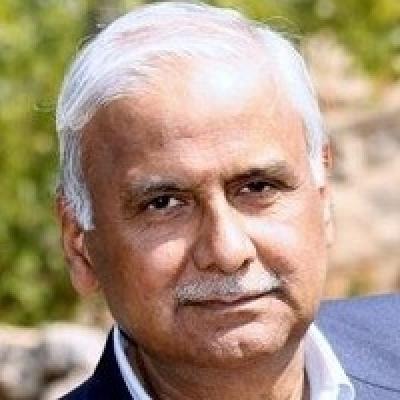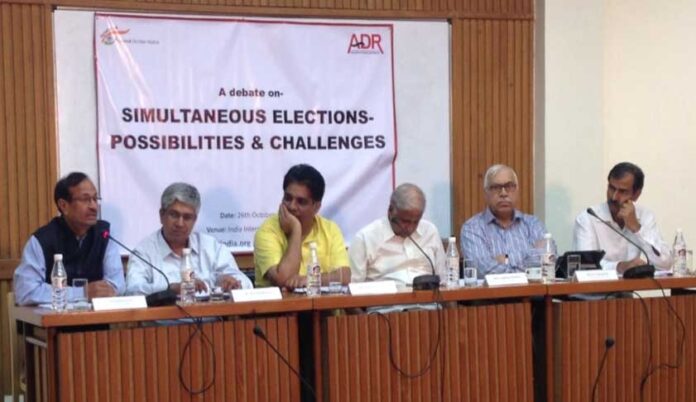By Mohammed Naushad Khan
NEW DELHI: An essay written on Simultaneous Elections earlier by Professor Jagdeep Chhokar a founding member of the Association for Democratic Reforms (ADR), and former director of IIM Ahmedabad on, “Simultaneous Elections: Striking at the Roots of Parliamentary Democracy has been published jointly by The Hindu Centre for Politics and Public Policy and Association for Democratic Reforms,” on 19 September 2024.
In this report, Professor Chhokar, has pointed that although Prime Minister Narender Modi has disavowed a direct role in pushing the idea, his imprint is clearly visible in the sequence of events aimed at kick-starting the exercise as well as in the urgency shown by the various arms of the government, not to mention an autonomous institution like the Election Commission: “Modi himself nudged and pushed the idea at every stage and on every institution”. As an example of the pressure that institutions have been facing on supporting and advocating simultaneous polls, the author cites the divergence in the views of former President, Pranab Mukherjee, held while in office and after retirement. As President, Mukherjee endorsed the holding of combined polls but on retirement rejected the same idea as an undemocratic and against the interests of the States.
In this Issue, Chhokar questions the submissions made in favour of combining Union and State elections and holds the move to be seriously flawed – both conceptually and in terms of its practicality. The exercise will require extensive amendments to the Constitution which will upset the balance of power between the States and the Union in the latter’s favour. This encroachment into federal rights has the potential to alter the basic structure of the Constitution, which has been held to be inviolable by the Supreme Court.

Jagdeep Chhokar
In practical terms, it will mean artificially cutting short or extending the terms of elected assemblies which strikes at the root of Parliamentary democracy. The author asks whether the conduct of elections, intrinsic to the survival and life of a democracy can be sacrificed at the altar of ‘development’ or administrative compulsions.
Chhokar also dismisses the argument that the Model Code of Conduct enforced in the run up to elections is an interference in governance by pointing out that the code imposed no restrictions that affect governance. On the spiralling cost of holding elections, a reason cited repeatedly by the proponents of synchronised polls, Chhokar asks: “Should the nation be looking to create the ‘most effective’ democracy or the ‘least expensive’ democracy?”
In its final observation, the Parliamentary Committee report said, “In most of the cases expenditures by the candidates are exceeding the ceiling fixed by the ECI”. This is worth examining in some detail. An analysis of the election expenditure affidavits of 6,753 candidates in the 2009 Lok Sabha election revealed that only four candidates said that they had spent more than the limit for their election expenditure limit. Thirty candidates said that they had spent between 90-100 per cent of the limit while 6,719 out of 6,753, or 99.99 per cent, of the candidates said that they had spent only 45-55 per cent of the limit.
“Even so, the observation of the Parliamentary Committee is not wrong. It is true that most candidates actually exceed the ceiling on the election expenses and go on to make false declarations in their election expenditure affidavits. To give an example: At a book release function on June 27, 2013, the late BJP leader, Gopinath Munde, was reported to have remarked that he had spent Rs.8 crores in the 2009 Lok Sabha election whereas he had declared in his election expenditure affidavit that he had spent only Rs.19.37 lakhs,” the report claims.
“The simple, and crucial, questions to ask are: Should the nation be looking to create the ‘most effective’ democracy or the ‘least expensive’ democracy? Is it possible, or is it even desirable or advisable, to assign a monetary value or cost to democracy? Should the country entertain the idea of “development” without or at the cost of democracy, the author argues.
On why police are not able to perform their role as mandated by the Constitution, the author has quoted Julio Rebeiro, former Director-General of Police, Punjab and Gujarat, “The police in India today are not expected to uphold the rule of law. They are trained to do that but as soon as officers are absorbed into the system, they quickly learn that all they are required to do is uphold the rule of the party in power…. Politicians of all parties and ideologies treat the bureaucracy and the police as private fiefdoms that will bow to their wishes as and when demanded.”
On the voting behaviour the author has noted the most recent observation on voter behaviour comes from no less a person than a former judge of the Supreme Court of India. Justice P.B. Sawant wrote on March 06, 2018, “It is common experience that people vote differently for the Lok Sabha and the state assemblies — for various reasons…Voters vote on local issues while voting for the state assemblies and are motivated by national and international concerns while electing their representatives in the Lok Sabha. But simultaneous elections may steamroll them into voting for the same party for both the Houses, although they do not desire to do so. This may distort the true opinion of the people. The purpose of election itself may thus be defeated.”
“The real issue which the NITI Aayog Discussion Paper deals with only perfunctorily is the sanctity and inviolability of the Constitution of India as interpreted by the Supreme Court. It is widely known, and accepted, that at least five articles of the Constitution (83, 85, 172, 174, 356) will require amendments for elections to Parliament and the State Assemblies to be held simultaneously. Opinions differ on the feasibility of amending the Constitution given the current political climate,” the author said.
“Proponents of simultaneous elections maintain that public opinion can be guided and built over time since, according to them, this is in the larger national interest. Opponents however see no national interest in carrying out large-scale amendments and say that such constitutional amendments are neither possible nor desirable. This therefore remains a matter of opinion. The fundamental issue however is: Even if such amendments were to be carried out, will they be valid? The reason for doubting the validity of such amendments lies in the federal character of the Constitution,” the author argues.
“The Basic Structure Doctrine lays down is that while Article 368 of the Constitution does give Parliament the power to ’amend by way of addition, variation or repeal any provision of this Constitution in accordance with the procedure laid down in this article’, Parliament does not have the power to amend the basic structure of the Constitution,” the report claims.
The report observes, “The question then is: Will holding elections to Parliament and State Assemblies simultaneously amount to indirectly interfering with the ‘federal character’ of the Constitution, in effect changing it into a “unitary structure”? Will this in consequence amount to an attempted change in the Basic Structure of the Constitution, thus violating the Kesavananda Bharti judgment? The answer to this question has been provided very recently by former Supreme Court judge, P.B. Sawant, in the following terms: “India is a federal state with its constituting units, the states, having the autonomy of governance in the subjects specified by the Constitution. Federalism is one of the basic features of the Constitution. The constitution of legislative assemblies and formation of state governments are autonomous functions. The Union government cannot interfere with the governance of a state except when there is a proclamation of Emergency under articles 352, 355 and 356 of the Constitution” (Emphasis added),”
In conclusions, the study reveals:
1. Attempts to hold elections to Lok Sabha and State Assemblies are not new. These have been around for a long time.
2. The idea gains momentum whenever a party feels it is in a dominant position and wishes to perpetuate its hold on the country.
3. The slogan “One nation, One election” is misleading because while the discussion is initiated with a stated intention to hold simultaneous elections to all three tiers of governance, the Union, the States, and the Local Bodies, the last tier of Local Bodies is invariably dropped from the discourse.
4. The government and its various arms have been quoting from the speeches of high constitutional authorities such as the President of India to gather support for the idea. However, Pranab Mukherjee who recommended simultaneous elections when in office has since resiled from that position, which shows that as President he merely reproduced the views of the government. His personal views are in conflict with that of the government.
5. Simultaneous elections to Lok Sabha and State Assemblies are not possible without significant amendments to the Constitution.
6. There are serious apprehensions that the advocacy of simultaneous elections is a sleight of hand aimed at changing the ‘federal’ character of the Constitution to a ‘unitary’ structure. The apprehensions arise from the fact that the justifications held out so far, such as lowering of expenses on elections, and improved governance, are found untenable on a deeper examination.
7. Such attempts at changing the character of the Constitution will violate the Basic Structure Doctrine — which has been held to be inviolable by the Supreme Court – and can thus be struck down.
8. The optimal course of action, in order to conserve precious national resources that are currently being expended on multiple discussions on holding simultaneous elections, is to give up this attempt, and focus on real issues facing the nation and its people.





